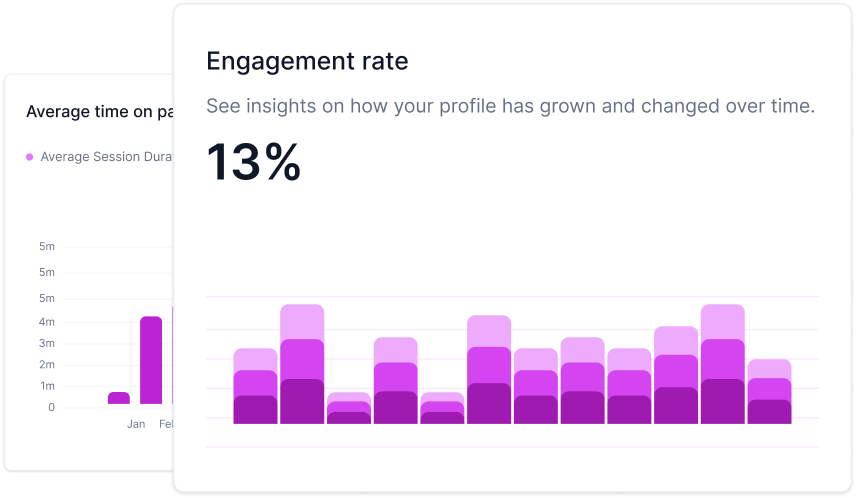What is the Bounce Rate?
The bounce rate is a metric in web analytics that measures the percentage of visitors who land on a webpage and then leave the site without interacting further, typically by navigating to other pages or taking any action, such as clicking on links or filling out forms. It's a key indicator of how engaging and relevant your webpage's content is to visitors. A high bounce rate may suggest that your page needs improvements to retain and engage users.
In the digital realm, understanding bounce rates is the key to unlocking a website's potential for engagement and success. In this article, we'll explore what a bounce rate is, answer three pivotal questions, and provide insights into how to measure, analyze, and improve this crucial metric.
What Is a Good Bounce Rate for My Website or Industry, and How Does Mine Compare?
Bounce rate is a web analytics metric that tells you the percentage of visitors who land on your website and then leave without interacting further, typically by navigating to other pages or taking any action. The question of what constitutes a "good" bounce rate is a common one, and the answer varies depending on factors like your industry and the nature of your website.
On average, a typical bounce rate falls between 40% and 60%. However, a "good" bounce rate is relative and depends on the purpose of your website. For example:
- Content Sites: Blogs and news websites often have higher bounce rates, as visitors might come for a single article and then exit. In this case, a bounce rate between 60% and 80% may be acceptable.
- E-commerce Sites: Online stores aim for lower bounce rates, typically around 20% to 45%, as they want visitors to explore products and make purchases.
- Service Sites: Service-based websites, like those of law firms or healthcare providers, often aim for a lower bounce rate to encourage visitors to contact them.
To determine whether your bounce rate is good or needs improvement, it's essential to compare it to industry benchmarks. Benchmark data can be found in industry reports or by using web analytics tools. By comparing your rate to these standards, you can gauge your website's performance and identify areas for enhancement.
What Factors Contribute to a High Bounce Rate, and How Can I Reduce It?
Several factors can contribute to a high bounce rate. Understanding these elements is key to reducing it:
- Page Load Speed: Slow-loading pages can frustrate visitors and lead to a high bounce rate. Optimize your site's speed by compressing images, reducing server response times, and using content delivery networks (CDNs).
- Relevance and Clarity: Ensure that your webpage content is relevant and easy to understand. Misleading or confusing content can cause visitors to leave in frustration.
- Mobile Optimization: With a growing number of users on mobile devices, ensure your site is mobile-friendly. A poor mobile experience can result in higher bounce rates.
- Attractive Design: An outdated or unattractive design can deter visitors. A modern, appealing design can encourage engagement.
- Navigation: A complex or confusing navigation structure can make it challenging for visitors to explore your site. Simplify navigation to guide users effectively.
- Call to Action: If your webpage lacks a clear call to action or next steps for visitors, they may leave without engaging further. Provide clear instructions or compelling reasons to explore further.
How Can I Measure and Analyze My Website's Bounce Rate, and What Actions Should I Take Based on This Data?
To measure and analyze your website's bounce rate effectively, follow these steps:
- Web Analytics Tools: Use web analytics tools like Google Analytics to track your website's bounce rate. These tools provide detailed insights into user behavior.
- Segmentation: Segment your data to understand which pages have higher bounce rates and which ones perform well. Focus on improving the pages with high bounce rates.
- Benchmarking: Compare your website's bounce rate to industry averages or competitors. This can provide context for your performance.
- A/B Testing: Experiment with changes to your website's design, content, and calls to action. Monitor how these adjustments impact your bounce rate.
- User Surveys and Feedback: Collect user feedback to understand why visitors might be bouncing. Use this information to make targeted improvements.
In conclusion, bounce rates are a critical metric for evaluating website engagement. By understanding what constitutes a good bounce rate, identifying factors that contribute to a high rate, and mastering measurement and analysis, you can take meaningful actions to improve your website's performance and provide a better user experience. Reducing bounce rates not only enhances engagement but can also lead to increased conversions and overall website success.

